
Balance activities22
23
Balance activities
- photos
- instructions
- tips
- changing habits.
What and when?
Balance activities need to be closely related to real life movements. You need to think about how you can incorporate increasingly challenging balance activities into your regular routine. This would include:
- daily activities (for example, showering, bathroom routines, dressing)
- household activities (for example, cooking, dusting, cleaning, washing, yard work, painting, washing the car)
- leisure activities (for example, gardening, dancing, bowls, darts, while reading and watching TV).
24
1.Tandem stand
Reducing your base of support
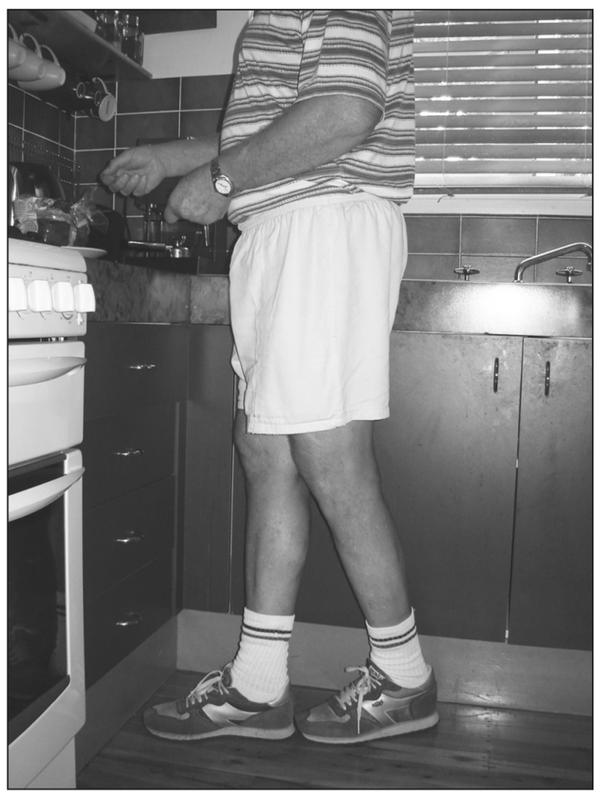
Tandem stand.
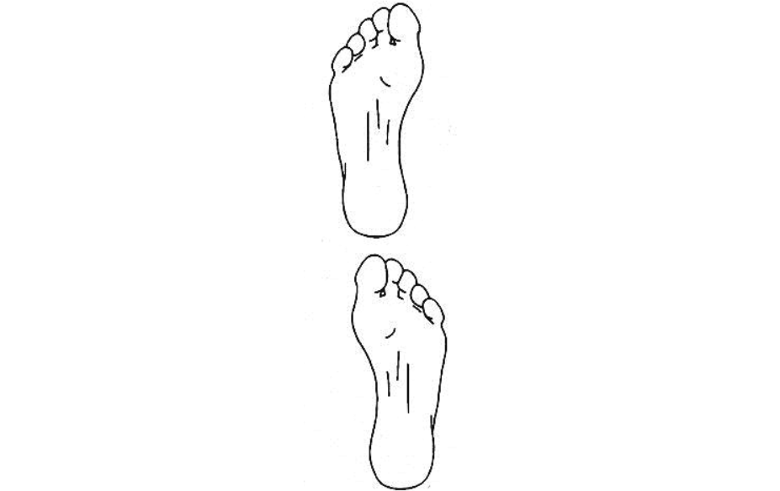
Correct foot placement for tandem stand.
Instructions
- Put the heel of one foot directly in front of the toe of the other.
- Swap the foot that is in the front.
25
Tips
Use support as needed from:
- hands
- tummy or hips
- knees.
Ideas of possible daily activities for doing the ‘tandem stand’ activity
Try tandem standing:
- At the kitchen bench while:
 waiting for the kettle to boil
waiting for the kettle to boil making toast
making toast heating food in the microwave.
heating food in the microwave. - At the bathroom sink while:
 cleaning your teeth
cleaning your teeth combing your hair.
combing your hair. - Other places while:
 waiting in a queue
waiting in a queue waiting at the bus stop or train station
waiting at the bus stop or train station waiting for the elevator
waiting for the elevator waiting for the computer to start up
waiting for the computer to start up watching TV
watching TV talking on the telephone.
talking on the telephone.
Safety note
Make sure that you have the necessary support readily available. 26
2. Tandem walk
Reducing your base of support
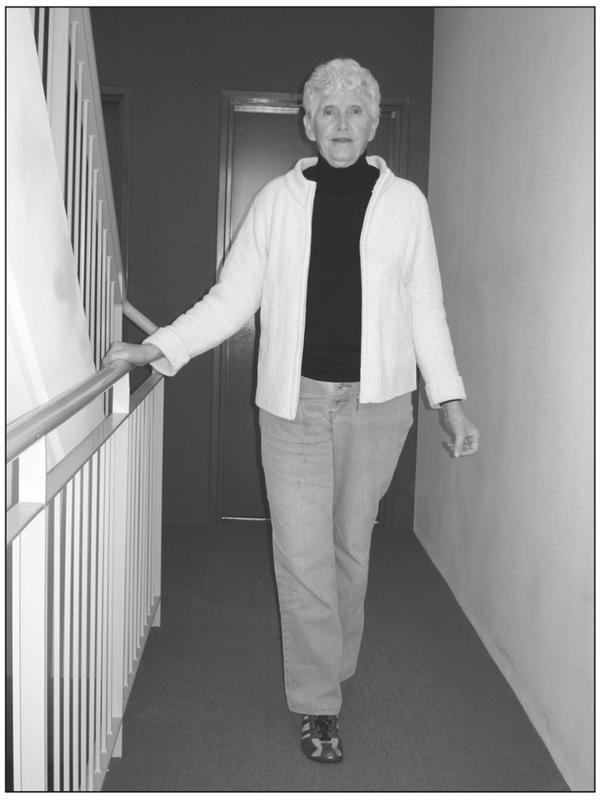
Tandem walk with support.

Correct foot placement for tandem walk.27
Instructions
- Walk heel-to-toe.
- Use a rail, bench or wall as support.
- Look at the floor if it helps you to balance.
- As you improve try to look straight ahead.
- Gradually decrease the amount of support you get from your hands.
Tips
- Try to get good foot placement.
- It is better to have correct foot position and be slow than be fast and have poor foot placement.
- Aim to walk slowly and with control.
Ideas of possible daily activities for tandem walking
Try to tandem walk:
- next to the kitchen bench
- along the hallway
- along the side of the house
- from the front of the car to the back of the car
- close to the wall from the kitchen to the lounge
- close to the wall from the bathroom to the bedroom
- next to the rail along the verandah
- next to the dining room table.
28
3. One-leg stand
Reducing your base of support
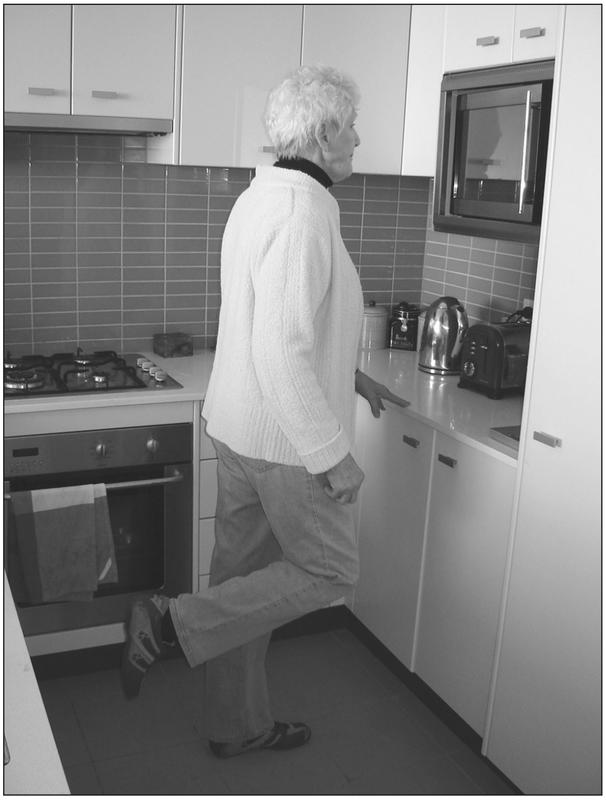
Standing on one leg waiting for the kettle to boil, using fingertips for support.
Instructions
- Stand on one leg.
- The position of the other leg can be varied.
- Support can be from hands, fingertips, trunk or the other foot.
- Support can vary depending on what you are doing.
29
Ideas of possible daily activities for doing a one-leg stand
Stand on one leg while:
- waiting for the kettle to boil
- heating food in the microwave
- waiting in a queue at the supermarket or bank
- waiting at the bus stop or train station
- cleaning your teeth
- making your lunch.
30
4. Leaning side to side
Shifting weight and moving to the limits of stability
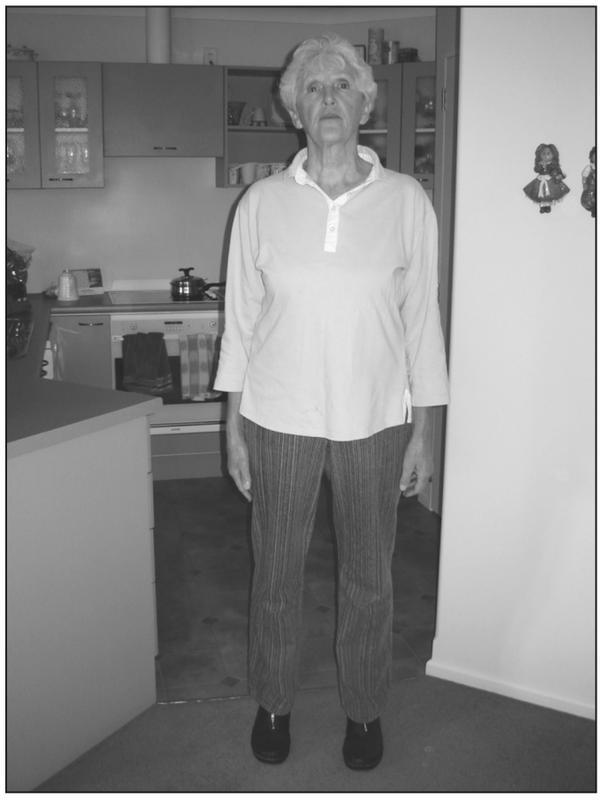
Starting position: feet apart and flat on the floor. Body neutral.
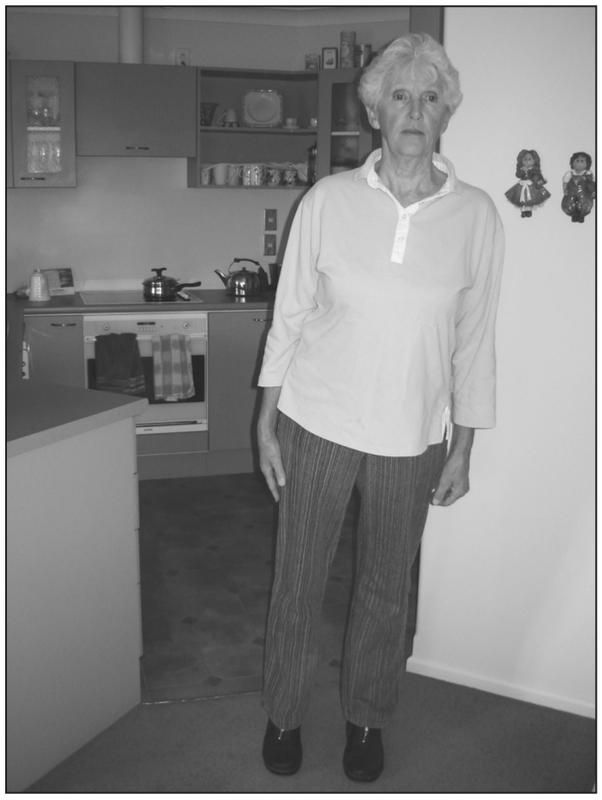
Lean to the left as far as possible by shifting weight onto the left foot.31
Instructions
- Stand with your feet apart and flat on the floor.
- Shift your weight onto one foot and lean as far as you can without losing your balance.
- Keep both feet on the floor.
- Feel the weight more on one foot than the other.
- Hold for a few seconds at the end of the movement.
- Do not bend at the waist.
- Keep your back straight.
- Shift your weight and lean to the other side as far as you can.
Tip
Do the activity near a wall or bench or doorway that you can hold if you need support.
Ideas of possible daily activities for doing the ‘leaning side to side’ activity
Shift weight from side to side while:
- watching TV
- waiting for the kettle to boil
- heating food in the microwave
- waiting at the bus stop or train station
- waiting in line at the supermarket or bank
- cleaning your teeth or brushing your hair
- talking on the telephone.
32
5. Leaning forwards and backwards
Shifting weight and moving to the limits of stability
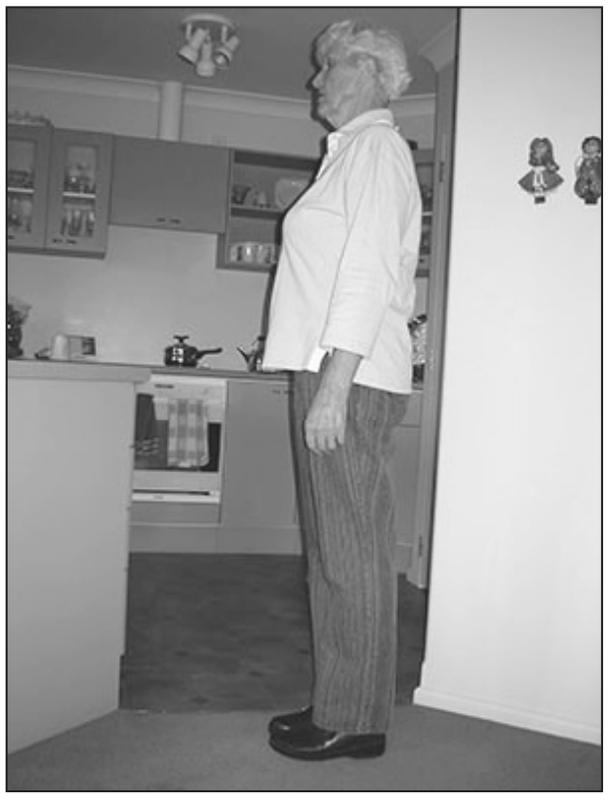
Starting position: feet apart and flat on the ground.
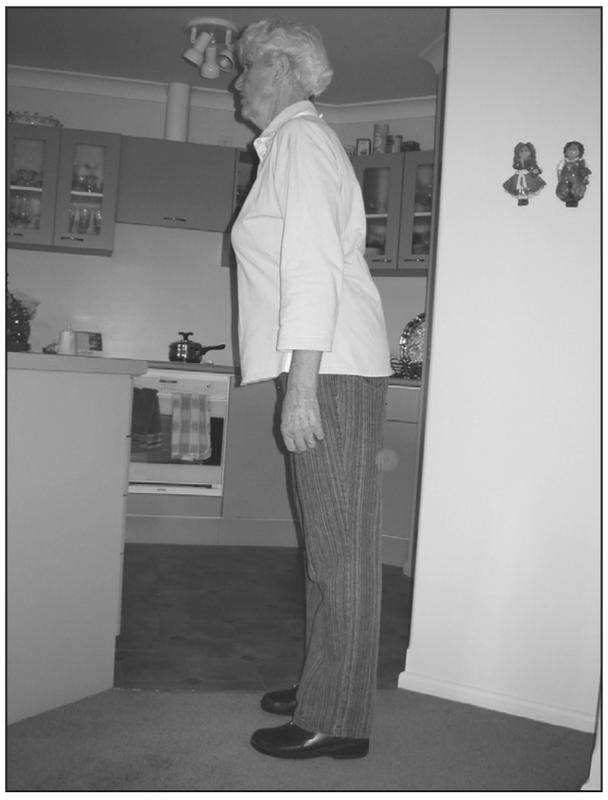
Shift weight forwards onto your toes and keep your heels on the ground. Weight should be felt more on the toes.
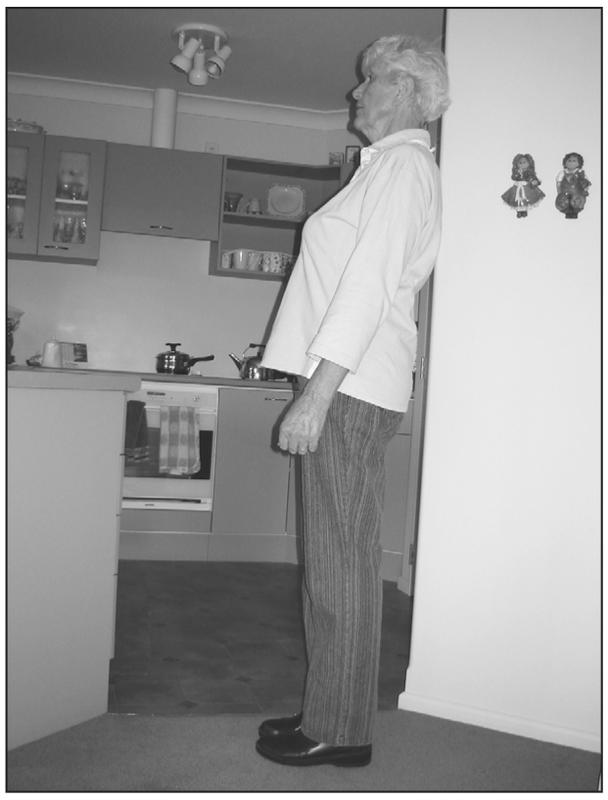
Shift weight backwards onto your heels and keep your toes on the ground. Weight should be felt more on the heels.33
Instructions
- Start with your feet apart and flat on the ground.
- Shift your weight forwards onto your toes; keep your heels on the ground.
- Keep your trunk straight; don’t bend at the waist.
- You should feel the weight more in the toes as you lean forwards.
- Shift your weight backwards into your heels, keep your toes on the ground.
- As you lean backwards you will feel the weight more in the heels.
- Lean as far as possible without losing your balance.
Tip
When shifting weight backwards have support ready.
Ideas of possible daily activities for doing the ‘leaning forwards and backwards’ activity
Have support readily available as you shift weight forward and backwards while:
- watching TV
- waiting for the kettle to boil
- waiting for heating food to heat in the microwave
- waiting at the bus stop or train station
- before and/or after dressing in the morning, (you can use your reflection in the bedroom mirror to guide you)
- talking on the telephone.
34
6. Stepping over objects – forwards and backwards
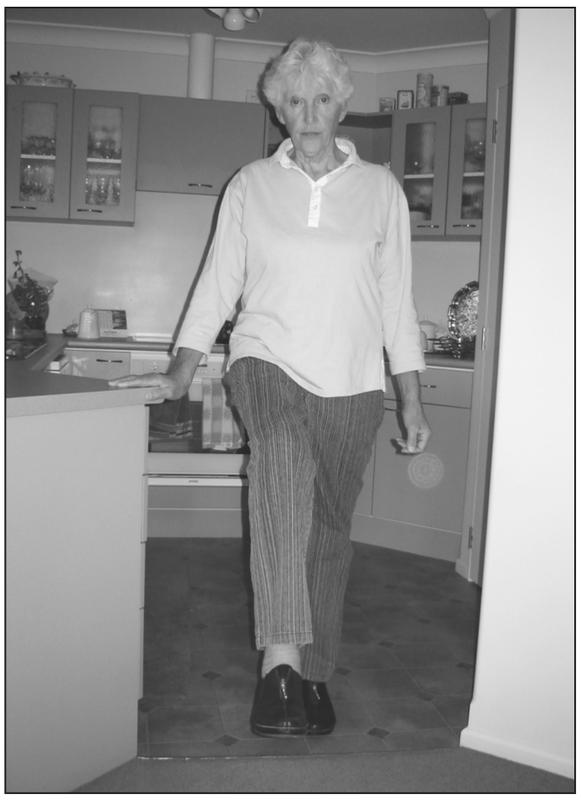
Stepping over the join between the lino and carpet using hand support.
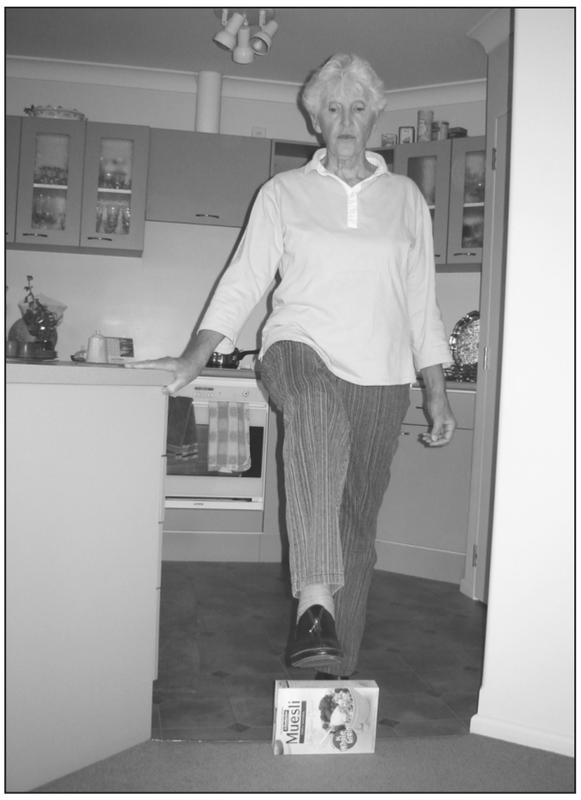
Stepping over an obstacle on the floor using hand support.35
Instructions
- Lift your leg high.
- Step forwards with one foot and then follow with the other.
- Then step backwards.
- Use support as needed.
- Look at the ground if it helps with balance.
Tips
- Doorways are a good place to start this activity.
- You can practise stepping over the edge of the carpet.
- Try to use something light as an obstacle.
- If doing this in a walkway don’t leave the object on the floor. Instead, squat to pick it up: you will be doing two activities in one.
Ideas of possible daily activities for doing the ‘stepping over objects – forwards and backwards’ activity
Step forwards and backwards over:
- the lino–carpet join in a doorway
- a sponge or cleaning cloth
- the doorway threshold as you walk in and out of the bathroom or laundry
- an object accidentally dropped on the floor, for example, a pen or hanky. Remember to bend your knees to pick it up after you have stepped forwards and backwards over it. Use support as needed.
36
7. Stepping over objects – side to side
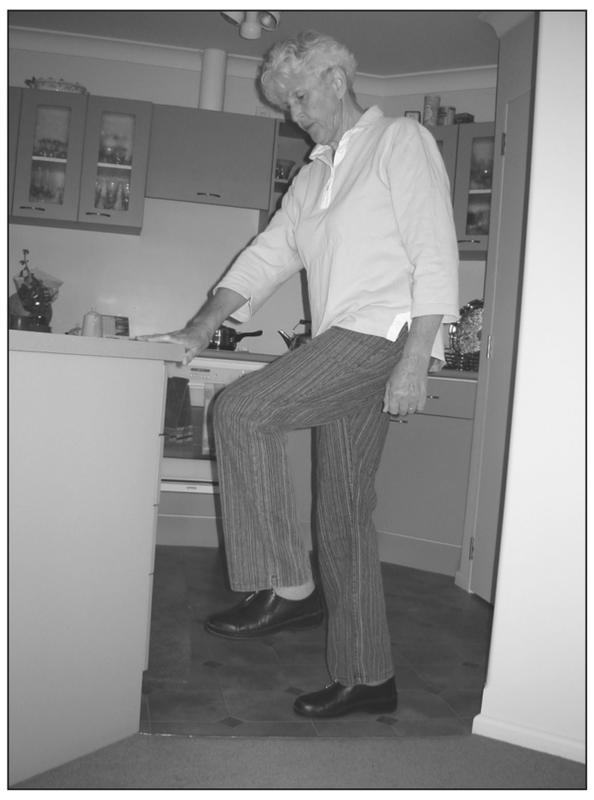
Stepping sideways over join between the lino and carpet using hand support.
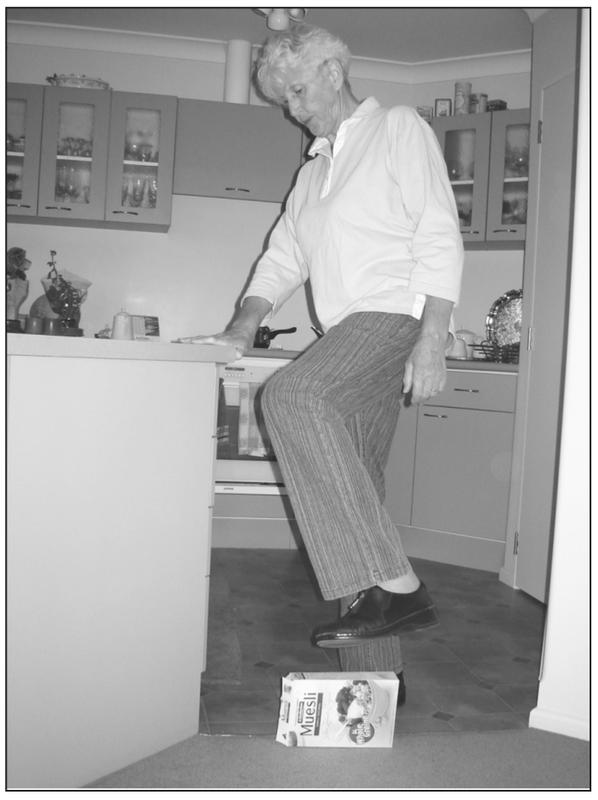
Stepping sideways over an object on the floor using hand support.37
Instructions
- Lift your leg high.
- Step sideways in one direction with one foot and then follow with the other.
- Then step back in the other direction.
- Use support as needed.
- Look at the ground if it helps with balance.
Tip
After finishing the activity, don’t leave the object on the floor. Instead, squat to pick it up: you will be doing two activities in one.
Ideas of possible daily activities for doing the ‘stepping over objects – side to side’ activity
Step sideways over:
- the lino or carpet join in the doorway
- a sponge or cleaning cloth
- the doorway threshold as you walk in and out of the bathroom of laundry
- an object accidentally dropped on the floor, for example, a pen or hanky. Remember to bend your knees to pick it up after you have stepped forward and backwards over it. Use support as needed.
38